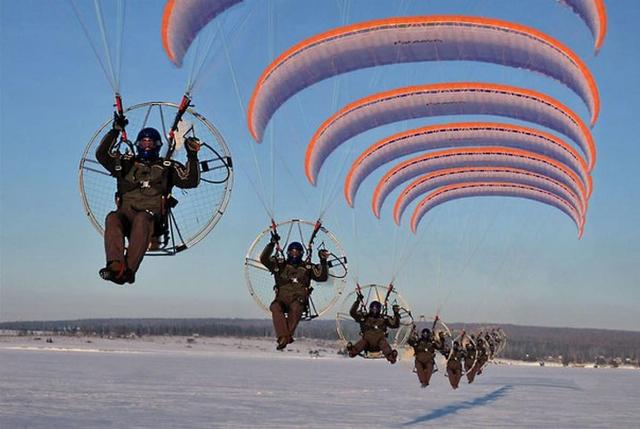During the hostilities that began on October 7, 2023 in the Gaza Strip, cases of the use of ultralight aircraft (SLA), namely, paragliders and motorized paragliders, were noted.
By experts, a paraglider is understood to be a motor SLA with a wing of a non-rigid (parachute) design, equipped with a trolley with a wheeled or ski landing gear, on which the pilot (additionally, possibly a passenger) is located. The device consists of two modules: a serial paraglider or its special modification and a trolley including a power frame, landing gear, pilot's seat, equipment, etc. The power plant is also mounted on it. Takeoff is carried out with a short takeoff run. In turn, a motorized paraglider is a paraglider with a power plant that allows you to take off from a horizontal platform. The power plant is attached to the suspension system and is located behind the pilot's back. Takeoff happens from the feet.
Both of the above types of SLA have similar flight characteristics. The flight speed is 25-50 km/h (on average). No specially prepared platforms are required for takeoff. A relatively flat field of 100x200 m is enough for takeoff and another 200 m of free space for climbing. To control the dome, the usual control links for parachutes of the "wing" type (sometimes called "clevants") are used and the ORE (engine control knob).
Transportation is also not difficult. The wing (paraglider) fits into a medium-sized backpack, and the engine with a guardrail in a special case. A small car trailer is used to transport the pallet truck. If desired, for greater secrecy of transportation, everything can be placed in a minivan.
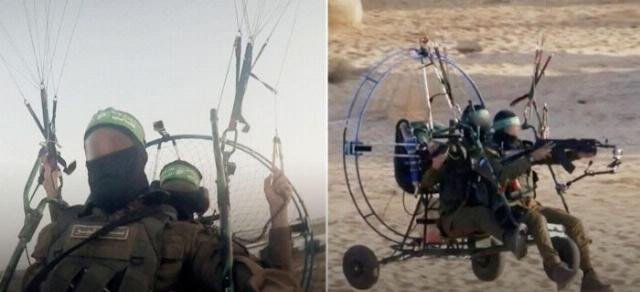
The use of SLA by Hamas militants
Ultralight aircraft were used by militants of the Palestinian Hamas movement at the initial stage of combat operations to covertly overcome barriers on the border with Israel, as well as to reduce the time required to arrive in the designated area (to the target of the attack).
It must be said that the first attempt at operational use of the SLA was made by Hamas in preparation for its operation "Dry Stubble" (7.07-08.26.2014, the response operation of the Israel Defense Forces (IDF) was called "Indestructible Rock"). The idea itself arose after the terrorist attack on November 25, 1987. Then two Palestinian saboteurs on paragliders penetrated from Lebanon into northern Israel. They managed to kill six soldiers and injure eight before the terrorists were eliminated.
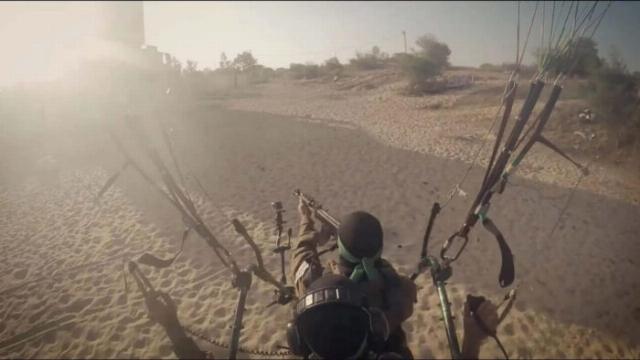
Hamas paragliding training in the Gaza Strip
Later, in 2010, a 15-man Hamas paragliding unit formed by one of the movement's top military leaders, Raed Attar, trained in Malaysia for a week. Further flight and combat training was carried out in the Hamas camps in Khan Yunis and Rafah. It should be noted that in the summer of 2014, the use of SLA by Hamas forces did not take place – Raed Attar was eliminated as a result of an Israeli airstrike on August 21, 2014, which prevented the attack.
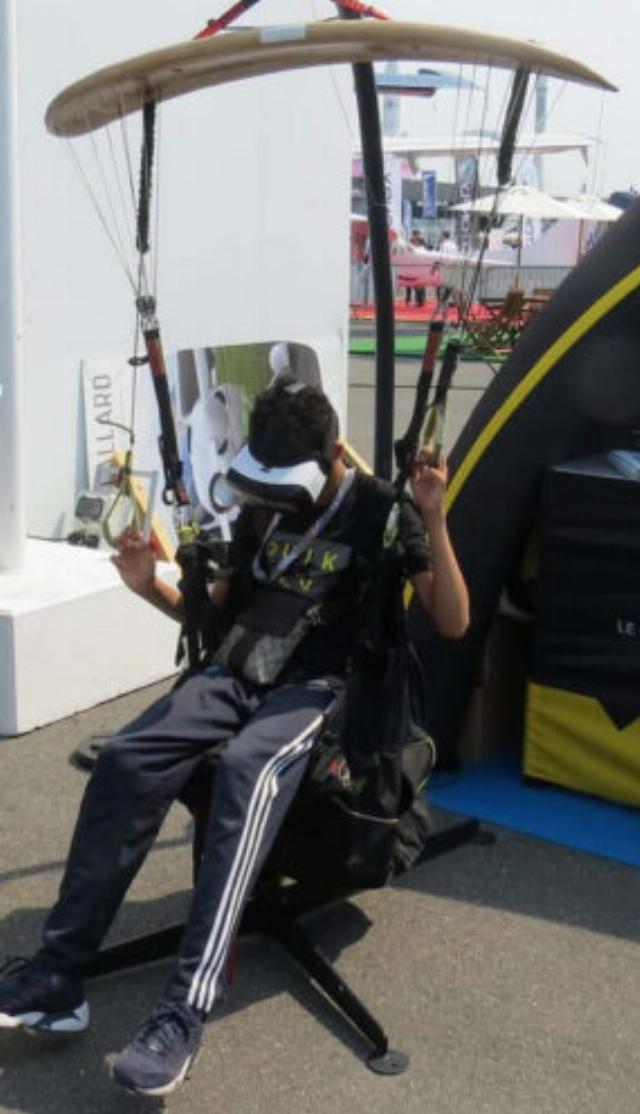
A virtual simulator for learning how to manage SLA
The flight training itself is not difficult. To gain the skills necessary for independent flights, two to three days of intensive theoretical training are enough, including classes on a virtual simulator and several more days of flights with an instructor. Although in some countries, for example in the USA, they are packed in three days.
Photos and videos distributed on social networks show up to 5 SLA with Hamas fighters in the air at the same time. Single-seat motorized paragliders and single/double paragliders were used. At the same time, a shooter with a Kalashnikov rifle, who was located in the front seat of a two-seater helicopter, fired in the air at ground targets.
It should be noted that the issue of using ultralight aircraft in the interests of special forces units (SpN) was dealt with back in the 1980s in the USSR. So, shortly before the collapse of the Soviet Union, about 20 trikes, designed and manufactured by the O.K.Antonov Design Bureau (Kiev, Ukraine), were supplied to 5 obr SpN (Maryina Gorka, Belarus). This is a motor SLA with a flexible wing and balancing control based on a hang glider. It is also called a deltalet. The wing of the trike consists of a power duralumin frame with steel cables and is covered with synthetic fabric. The motorcycle is made of power elements, includes a supporting frame, chassis, engine with gearbox and propeller, instrumentation, fuel tank, seat for the pilot and passenger. The Design Bureau also studied the issue of practical testing of dropping a trike with a pilot from an airplane.
Experimental parachute jumps were also performed from them. Even then, our specialists, after a short operation, concluded that the use of SLA was possible, mainly, only for covert and rapid overcoming of the line of contact (front). In the course of combat operations, due to their visibility (large dome size) and low speed, their use is problematic.
The idea of using SLA was tried to revive in the recent past in the Airborne Forces of the Russian Federation. So in March 2010, during the 76 dshd command and staff exercises, in the presence of the Commander of the Airborne Forces, Lieutenant General V. Shamanov and military attaches of a number of NATO countries in the Pskov area, the use of motorized paragliders for reconnaissance and paragliding to provide fire support from the air to the SpN group was demonstrated.
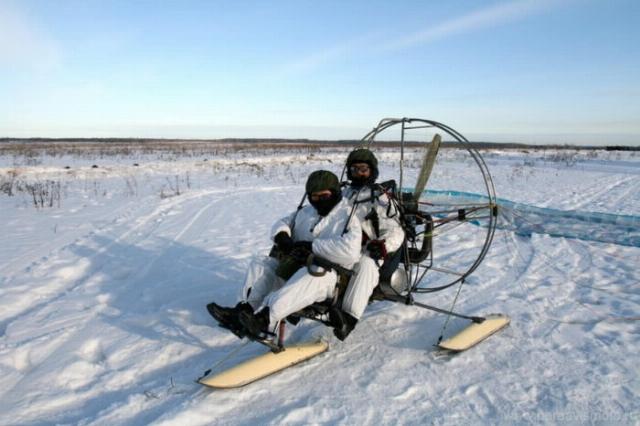
Motorcycle paraglider on exercise 76 dshd. March 2010
The two-seat Skat paraglider and motorcycle paragliders were provided by the Moscow company ParAAvis. After these exercises, the Commander of the Airborne Forces announced at a press conference that the Airborne Command plans to equip paratroopers with ultralight aircraft to conduct reconnaissance and combat enemy UAVs. But these grandiose plans have remained only plans.
However, it turns out that our closest allies, the Belarusians, have not abandoned the idea of using SLA in the interests of special forces units. In the May-June issue of the Army magazine for 2022 (the official publication of the Ministry of Defense of Belarus), an article "Wings for Special Forces" was published, which tells about the combat training of one of the units of the 5th OBR SpN using trikes.
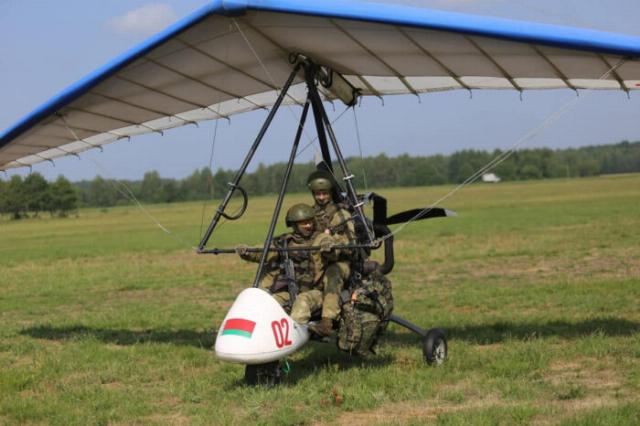
Antares motorized motorcycle
It is reported that they have been used in the Belarusian army for over 10 years. 5 obr SpN are armed with two-seat Antares trikes, which can develop a maximum of. The speed is up to 124 km/h. They are used for parachuting personnel and cargo by parachute and landing methods (containers with a load capacity of up to 50 kg can be attached on each side of the SLA), conducting aerial reconnaissance, transporting cargo weighing up to 110 kg (if only one pilot is on board), solving fire tasks.
At the same time, when parachuting, only special-purpose parachute systems are used with manual activation of the main dome of the "wing" type, which imposes additional high requirements on the level of training of a scout parachutist. When flying at a cruising speed of 64 km/h, the flight range can reach up to 322 km. The fuel tank capacity is 19 liters.
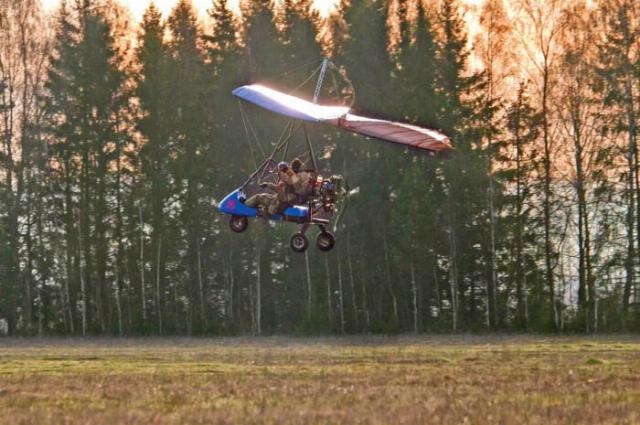
Take-off of the Antares two-seater trike
During combat training, they practice flying along a given route day and night with a night vision device, including with the engine turned off, landing on a platform selected from the air, dropping cargo, shooting from the air at ground targets, as well as bombing.
In the above-mentioned article it was reported that autogyros began to enter service with the Belarusian brigade. Apparently, Belarusians have begun to adopt the experience of the units of the People's Liberation Army of China (PLA), where these light aircraft are actively used. An autogyro is an ultralight aircraft heavier than air, in which the lifting force is created by a freely rotating main rotor (without an engine drive) under the action of an incoming air flow, and the gyroplane receives translational motion from a conventional pulling or pushing propeller.
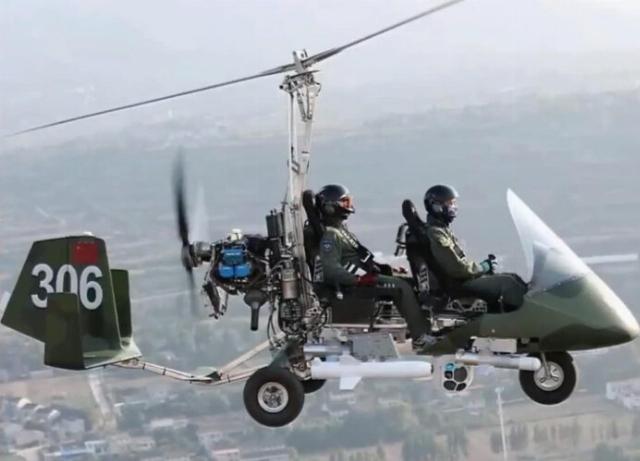
Two-seat gyroplane PLA
As a confirmation of this, at the International Exhibition of Military-Industrial Complex "MILEX-2023", held in Minsk in May 2023, the joint Chinese-Belarusian CJSC Aviation Technologies and Complexes presented the autogyro "Hawk". Later, there were reports of the use of an autogyro during combat training of servicemen of the 5th obr SpN.
The Hawk gyroplane with a maximum take–off weight of 560 kg (payload weight - 265 kg) can fly at a cruising speed of 130 km/h at a range of up to 500 km. The maximum flight duration is 3.5 hours when refueling 80 liters of fuel. It is equipped with a 140 hp AAT 912 RSTI piston engine. Takeoff run with max. takeoff weight – 80-150 m, run – 0-10 m. It is designed to solve the same tasks as the Antares trike.
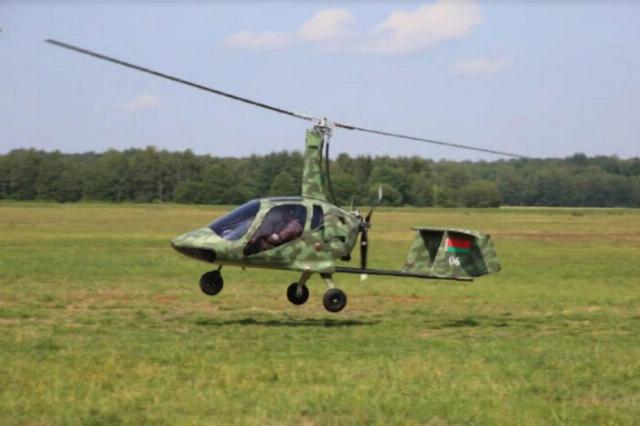
Autogyro "Hawk"
The Ministry of Internal Affairs of the Russian Federation also showed interest in the use of SLA. Thus, at the Geodesy Research Institute training ground, during ostentatious exercises within the framework of International exhibitions of military products of the Ground Forces, as well as Interpolitech security equipment and systems, the possibilities of using SLA were demonstrated several times, in particular to ensure anti-terrorist operations. They were supposed to be used to conduct surveillance and search for persons hiding in hard-to-reach areas, search for missing persons, inspect crowded places, survey hard-to-reach areas adjacent to the railway track, and even to ensure the safety of the Olympic Games in Sochi in 2014. According to calculations by specialists from the Ministry of Internal Affairs of the Russian Federation, the effectiveness of using paragliders and motorized paragliders according to the "cost-effectiveness" criterion is higher than that of light UAVs. But even here, all calculations remained only on paper, and the matter was limited to individual ostentatious exercises.
But the Hamas militants have managed to find a use for them, albeit on a limited scale. In addition, according to Turkish Interior Minister Ali YERLIKAI, two perpetrators of the terrorist attack at the Interior Ministry building in Ankara on October 1, 2023 used a motorcycle paraglider to cross the border between Syria and Turkey, because, according to him, there are no traces of their crossing the border.
And as for China, in 2019, during the annual military parade, an entire unit on special gyroplanes passed in front of the stands with numerous guests (more precisely, it passed, because gyroplanes with two military personnel in each were placed on trucks).
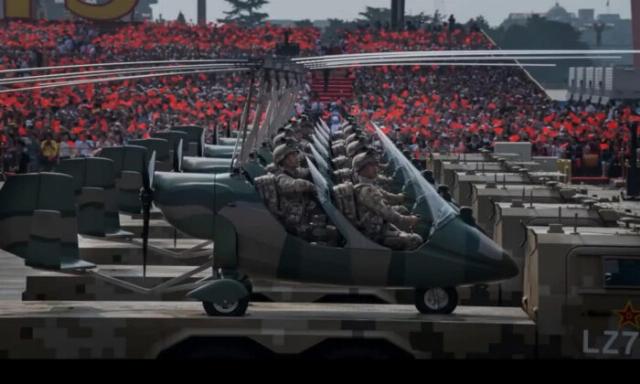
PLA gyroplanes at the 2019 parade
Special units of the PLA are armed with two and three-seat gyroplanes under the general name “Hunting Eagle”, which are developed and produced by the local company Shaanxi Baoji Special Vehicles Manufacturing. They are designed for transporting and landing (by landing and air methods) military personnel, conducting reconnaissance and fire support for ground units using installed guided missiles or small arms of the crew. Gyroplanes are also supplied by Chinese law enforcement agencies.
The flight specifications of both modifications are approximately the same and for a two-seater, the main ones are: max. take–off weight – 560 kg, payload weight - 230 kg, max. ceiling – 4,500 m, cruising speed – 100-120 km/h, max. flight range – 400 km, flight duration – 4 hours, take–off length – 20-80 m, run length - 20 m.
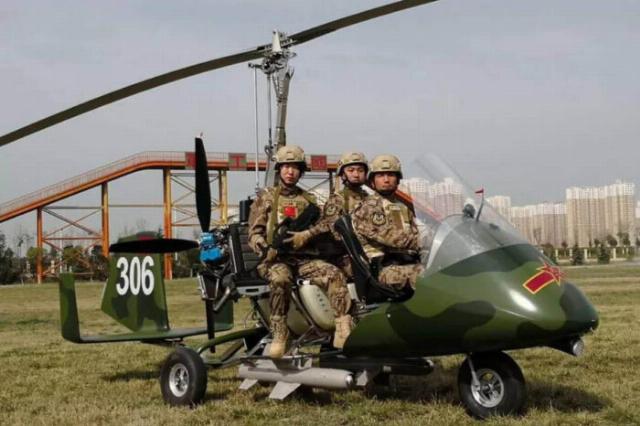
PLA triple gyroplane
By chance or not, but shortly before the outbreak of hostilities in the Gaza Strip (October 2023), at the end of August 2023, representatives of the US Air Force Development Command during a traditional meeting with companies developing parachute landing equipment (PDT), held under the auspices of the Association of Manufacturers of PDT (ParachuteIndustryAssociation, PIA) It was reported that one of the new areas of work to improve the PDT for the US Armed Forces is to explore the possibilities and develop experimental samples of motorized paragliders and paragliders to ensure the withdrawal of scouts to the combat mission area at a range of up to 300 km, as well as their evacuation to the location of their troops. To this end, the Office of Advanced Research of the US Department of Defense has already concluded several contracts within the framework of the program for attracting small firms to innovative developments.
In addition, the US military has experience in the operation and combat use of paragliders. In 2003, the US Special Operations Command signed an agreement with the Canadian firm MMIST Inc. for the supply of unmanned CQ-10A “SnowGoose” helicopters to provide psychological operations (dropping leaflets and other propaganda materials, broadcasting radio broadcasts) in Iraq and Afghanistan. A total of 74 devices with appropriate controls and support were purchased. The SLA was also used to deliver goods to units operating in isolation from their locations and supply points.
CQ-10A "SnowGoose" unmanned helicopter
The CQ-10A paraglider can take off independently from the body platform of a specially equipped cross–country vehicle of the HMMWV type or a trailer moving at a speed of 55 km/h along a straight section (take-off length is 228 m), as well as be dropped by gravity from aircraft of the C-130 or C-17 type.
Cargo (or equipment) on the paraglider is placed in six compartments of 45 kg each. Loads can be parachuted from a height of up to 900 m with a delay in the introduction of a one-time parachute system to ensure the accuracy of cargo landing. The paraglider is capable of delivering 135 kg of cargo when flying along a route up to 250 km long to three spaced landing sites or up to 50 km long to six sites. Cargo delivery operations can be performed offline. Cargo delivery by boarding method is possible. But in this case, a specially equipped car and a prepared launch crew are required to take off the paraglider for the purpose of returning.
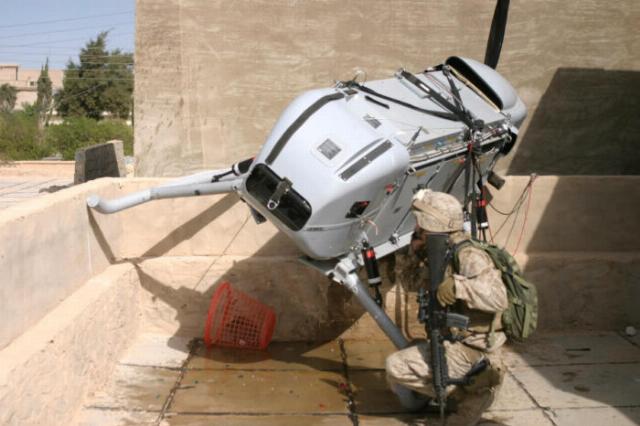
Operational use of the CQ-10A SLA in Iraq
The flight is serviced by a crew of four people. The preparation time of the CQ-10A for reuse after landing is no more than 4 hours, including for laying the parachute system with a calculation of two people – about 1 hour. To install on the machine and prepare the paraglider for takeoff from the ground, the calculation requires about 10 minutes.
A non–motorized version of an ultralight aircraft – a paraglider - is supplied by the 27 OGPBR of the French Army and is used by the reconnaissance units of this brigade when conducting reconnaissance in the mountains or for accelerated access to a designated area (occupation of an advantageous frontier, for example, a pass). Actions on paragliders are periodically practiced during combat training and exercises at any time of the day and year. In winter, the method of landing on downhill skis is used, followed by descent from the mountains.
In addition, in the 2010s, in a number of countries, including the United States, Great Britain and France, the issue of using paragliders based on buggy-type light cross-country vehicles for the covert withdrawal of reconnaissance groups to the task area was studied in detail. Samples of such machines in various modifications have been repeatedly demonstrated at major international exhibitions of weapons and military equipment, as well as aerospace.
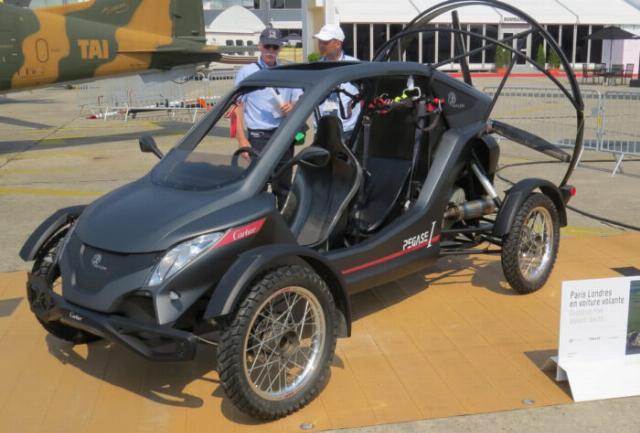
The Pegasus paraglider based on the buggy
For example, the French company Vaylon has developed a Pegasus paraglider based on a buggy-type machine. It has been repeatedly demonstrated at exhibitions of the Air Defense Forces and the air defense forces "Eurosatory", the Paris Air Show aviation and space exhibition, etc. Basic flight technical data: airspeed – 80 km/ h, ceiling – 3000 m, take–off length – 50-100 m, run length - 10-30 m, flight duration – 3 hours, payload weight – 250 kg. On the road, the car can move at speeds up to 100 km / h, the power reserve is about 500 km.
In June 2017, this aircraft flew from France to the UK across the English Channel. The flight length was 37 km, the duration was 45 minutes. One vehicle (according to other sources – two) was purchased by the French Special Operations Command for familiarization and evaluation tests in order to determine the need for adoption.
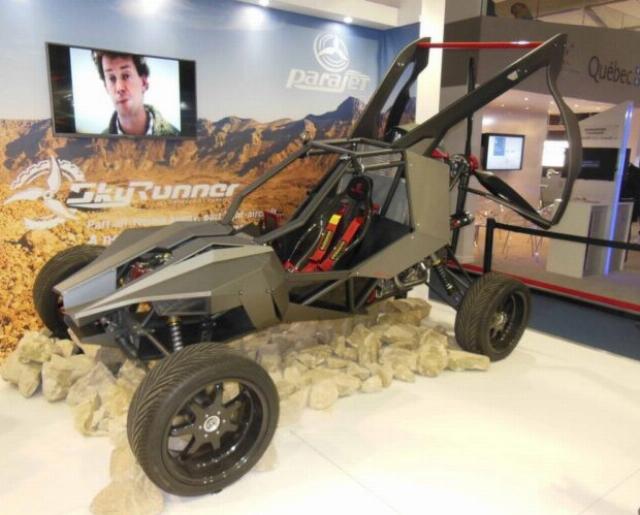
The Skyrunner flight
A similar project was developed by the British firm ParaJet International Ltd. The SkyRunner and PADSS paramotor were presented at the International Aviation and Space Exhibition in Farnborough in 2014. The main flight technical data of the paraglider: weight – 234 kg, airspeed – 80.5 km / h, ceiling – 4000 m, flight duration – 2.5 hours, flight range – 322 km. On the road, the car can move at speeds up to 137 km/h, with a power reserve of 386 km.
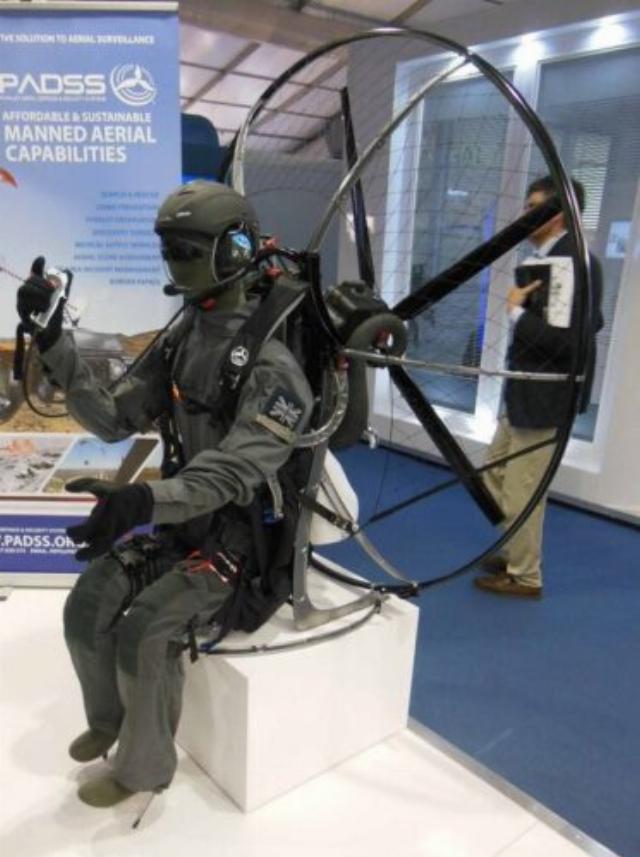
PADSS Paramotor
But, despite the active marketing work of the above-mentioned and other companies, the adoption of certain SLA samples did not happen. However, in June 2023, the Office of Science and Technology of the Ministry of Defense of the United Kingdom (DefenceScienceandTechnologyLaboratory, Dstl) concluded an agreement with the above-mentioned British company for the supply of five SLA (type is not specified) for a total amount of more than 221 thousand pounds. sterling. That is, as in the United States, research continues, and the topic of the use of ultralight aircraft for military purposes is not completely closed.
Similar tools have been developed and offered to potential customers in Russia. Back in 2009, the high-latitude experiment “North Pole–2009” was carried out at the Barneo ice station, during which a number of tests were carried out on a soft—wing SLA - Begalet - Arctic 1, which rose from the drifting station to a height of 4721 m. Thus, back in those years, the highest world achievement in flying in high latitudes of a small SLA was established. Designer A.Begak and his team were congratulated by the famous polar explorer A.Chilingarov.
In 2017, during the International Aviation and Space Exhibition MAKS-2017 (Zhukovsky, Moscow region), two companies: NPO Aerospace Technologies LLC and Electroautomatics JSC demonstrated the joint development of the same designer – BORTS (three elements operational reconnaissance aircraft) Triton, a paraglider based on a two-seat amphibious transformer capable of "moving on the ground like an electric vehicle, with the ability to fly like a soft-wing aircraft (aeroshute) and move through the water (aeroglisser)," as stated in the advertisement. The machine with a maximum take–off weight of 500 kg (payload weight - 350 kg) is capable of flying at an altitude of up to 4,200 m and a range of up to 400 km. However, the further fate of this project is unknown to the author.
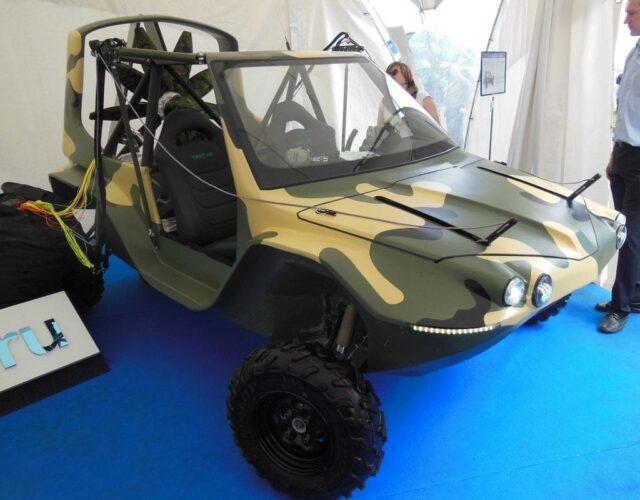
BORTS (three elements operational reconnaissance aircraft) "Triton"
In conclusion, it can be said that ultralight aircraft have their own, albeit very limited, scope of application in the interests of special forces units during combat operations in the absence or weak enemy air defense. In addition, special training of personnel and additional time during combat training are required to maintain previously acquired skills in the use of SLA.
The materials and photographs obtained (taken) by the author at the International Aviation and Space Exhibitions MAKS (Russia), Le Bourget (France), Farnborough (Great Britain) and the International Military-Technical Forum "Army" in different years, as well as the Internet resources of SLA manufacturing companies, were used.
